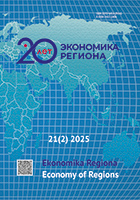Assessing Labour Resource Efficiency: A Territorial Perspective
DOI:
https://doi.org/10.17059/ekon.reg.2025-2-14Keywords:
labour resource efficiency, labour productivity, fixed asset investment, wage expense efficiency, wage fund, average annual salary, territorial socio-economic differentiationAbstract
Russia currently faces a labour market shortage alongside historically low unemployment rates. Enhancing the efficiency of available labour resources is, therefore, a critical public administration priority. However, spatial imbalances at the municipal level exacerbate regional development disparities and socio-economic asymmetries. This article proposes a methodological toolkit to assess labour resource efficiency across municipalities. Key methods include statistical analysis, simple grouping, ranking, and expert evaluation, with experts selected via self-assessment. Using data from Stavropol Oblast, the study evaluates indicators such as output per employee, profit and loss balance per employee, fixed asset investment per employee, and wage efficiency. Integration of these indicators enables classification of municipalities into three groups: growing: high labour productivity, wage efficiency, profitability, diversified economy, and development in agriculture, industry, and trade; stable: labour resource efficiency approximately 15 % below the regional average; and degrading: low productivity, profitability, wages, and weak investment attractiveness. These results can be used to inform spatial development strategies, including workforce training, population resettlement, wage equalization, and targeted programs to boost labour productivity, which may ultimately help reduce socio-economic disparities among municipalities.
Downloads
Published
How to Cite
Issue
Section
License
Copyright (c) 2025 Кальная Анастасия Юрьевна , Кривокора Евгения Ивановна , Калюгина Светлана Николаевна

This work is licensed under a Creative Commons Attribution 4.0 International License.




